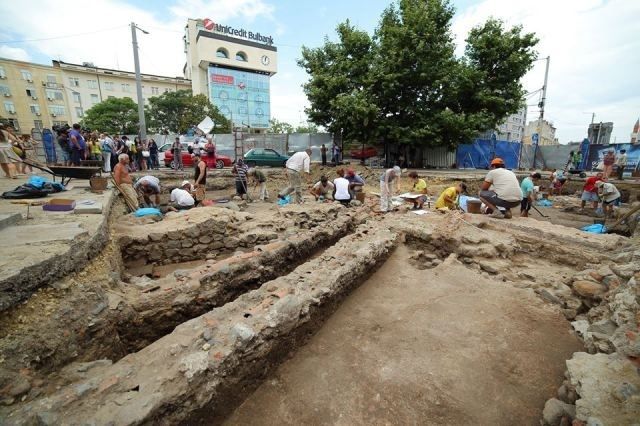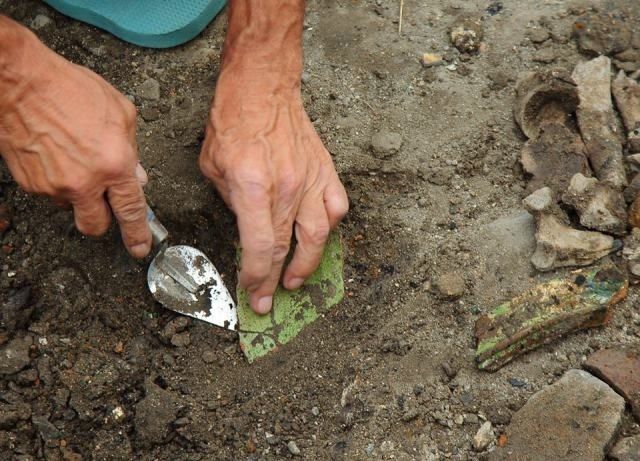Post by UKarchaeology on Aug 17, 2015 11:51:49 GMT


(2015) A massive Roman building which might be either ancient thermae (public baths), or the legendary palace of Roman Emperor Constantine the Great (r. 306-337 AD), has been discovered by the archaeologists excavating the ruins of the Ancient Thracian and Roman city of Serdica in the downtown of the Bulgarian capital Sofia.
The excavations of the square near the St. Nedelya (“Holy Sunday) Cathedral and the Hotel Balkan (formerly the Sofia Sheraton) started on July 20, 2015, with the archaeologists and the authorities of Sofia Municipality expecting the discovery of the forum of the ancient city of Serdica. Instead, however, the researchers have come across the walls of the large-scale Roman building.
The ruins of the ancient building have been reached at a depth of only 20-30 cm below the St. Nedelya Square; the width of its walls ranges from 1.8 to 2.3 meters leading to hypotheses that the building had several floors.
The building in question was destroyed in the 5th-6th century AD but the archaeologists are unable to say for sure when it was built. Depending on the possible time of its construction they have two major hypotheses about their new discovery – that it was either the Serdica Thermae, or the legendary Serdica palace of Roman Emperor Constantine the Great.
Lead archaeologist Assist. Prof. Veselka Katsarova from the National Institute and Museum of Archaeology in Sofia has told bTV that if the building was built in the 2nd century AD as part of the all-out urban planning of ancient Serdica, it was probably the Serdica Thermae, as the thermae were generally the largest public building in every Roman city; in this case, it is unlikely that this was the location of the city forum.
However, if the newly found building turns out to have been erected in a later period, it might have been the city praetorium, i.e. the military command and administrative center, or the legendary residence of Roman Emperor Constantine the Great.
In addition to the building walls, the archaeologists excavating the ruins of Serdica on the St. Nedelya Square in the Bulgarian capital Sofia have found parts of a hypocaust (underfloor heating), coins, and fragments of marble plates as well as other archaeological artifacts from different time periods.
“The results from our excavations have come surprisingly quickly because we know that the archaeological layers underneath today’s Sofia reach a considerable depth of 5 meters, while the Antiquity layers usually can be found at a depth of 3 meters. However, because of the urban development, and the several reconstructions of the square, a large part of the later layers were removed, and the masonry from the Antiquity has turned out to be right under the level of the St. Nedelya Square,” Katsarova explains, as cited by the Cross news agency.
In her words, the newly found large Roman building was probably abandoned completely at the end of the 6th century; it underwent several reconstructions based on the masonry and the different types of mortar used.
“For the time being, we keep finding coins and window glass as well as individual fragments of marble plaster showing that the building was richly decorated on the inside. Unfortunately, these are small pieces but we also hope to find more considerable ones,” she says.
The archaeologist adds that the excavations can be expanded south in the direction of the St. Nedelya Cathedral in order to check if the newly revealed structure is the same as a massive Roman building partly revealed and documented in the 1950s.
Back in December 1953, before the construction of the so called Sofia Largo, i.e. the large Communist Era government buildings in downtown Sofia, including the building of the Sofia Hotel Balkan, the archaeologists were allowed in to study the site for a brief period of time.
However, they only managed to excavate the outskirts of the supposed Forum, and to document part of the ruins of the so called Building No. 6 which may have been a passage into the ancient square.
“Indeed, this is a unique scientific chance that our colleagues have come upon these structures at the start of their expedition. This is one of the largest buildings in Bulgaria from the Roman period, whose façade is about 70 meters [long] making it grandiose even according to contemporary standards,” says archaeologist Todor Chobanov who is a Deputy Mayor of Sofia.
“I am convinced that the National Institute and Museum of Archaeology which works together with our Museum [of Sofia History] has the capacity to bring this effort to a successful conclusion so that this precious cultural heritage, which has been sitting under our feet for 1,500 years, now can have a second chance to appear,” he adds.
Chobanov reveals the newly found archaeological structures might have to be temporarily reburied until the planned all-out reconstruction of Sofia’s downtown which is supposed to integrate the contemporary buildings with the buildings of Ancient Serdica.
In the past, Bulgarian archaeologists have hypothesized that the ground below the St. Nedelya Square might hide the palace of Roman Emperor Constantine the Great (r. 306-337 AD) who is known to have said, “Serdica is my Rome”.
Emperor Constantine, who was a native of Nis in today’s Serbia, is known to have considered Serdica, today’s Bulgarian capital Sofia, as a possible place for relocating the capital of the Roman Empire before he chose Constantinople.
The Sofia authorities are currently working on the completion of the reconstruction project for the so called Sofia Largo expected in the fall of 2015.
Meanwhile, the design of the three glass domes to cover the archaeological structures at the Sofia Largo has been made public.
In March 2015, Deputy Mayor of Sofia Todor Chobanov announced that in addition to the Sofia Largo project Sofia Municipality also planned to excavate and exhibit in situ the Western Gate of Ancient Serdica and the mosaics inside the St. Sofia Basilica.
Background Infonotes:
The Ancient Thracian and Roman city of Serdica is the precursor of the contemporary Bulgarian capital Sofia. The oldest traces of civilized life in Sofia are from a Neolithic settlement dated back to 5000 BC located in today’s Slatina Quarter. There are also traces of life from the Charcolithic (also known as Aeneolithic or Copper Age) and the Bronze Age. After the Bronze Age the Sofia Valley was inhabited by the Ancient Thracian tribe serdi (some believe them to have been a Celtic tribe) which gave the name to the Ancient Thracian settlement called Serdica or Sardica. The city of Serdica was conquered briefly in the 4th century BC by Philip II of Macedon and his son Alexander the Great. Around 29 BC, Sofia was conquered by the Romans and renamed Ulpia Serdica. It became a municipium, the center of an administrative region, during the reign of Emperor Trajan (r. 98-117), and saw extensive development with many new buildings. It is known to have been the favorite place of Roman Emperor Constantine I the Great who used to say, “Serdica is my Rome”.
In 343 AD, the Council of Serdica was held in the city, in the 4th century church that preceded the current 6th century St. Sofia Basilica. In 447 AD, the city was destroyed by the Huns. During the reign of Byzantine Emperor Justinian I (r. 527-565 AD), a new fortress wall was built whose remains have been excavated and can be seen today. This is when it was renamed Triaditsa. It became part of the First Bulgarian Empire (632/680 – 1018 AD) in 809 AD when it was conquered by Bulgaria’s Khan Krum, and was known by its Slavic-Bulgarian name Sredets until the 14th century when it took the name of the St. Sofia Basilica.
The Sofia Largo is the architectural complex of government buildings in downtown Sofia erected in the 1950s, in the early years of the former communist regime. Regardless of their Communist Era architecture, today the buildings house the most important Bulgarian government institutions and are one of the most famous parts of Sofia’s cityscape. Parts of the ancient city of Serdica, which have been excavated, can be seen in the underpasses and the Serdica Metro Station right next to the Sofia Largo.
(More pics & source: archaeologyinbulgaria.com/2015/08/06/archaeologists-discover-massive-roman-building-from-ancient-serdica-in-bulgarias-capital-sofia/ )
